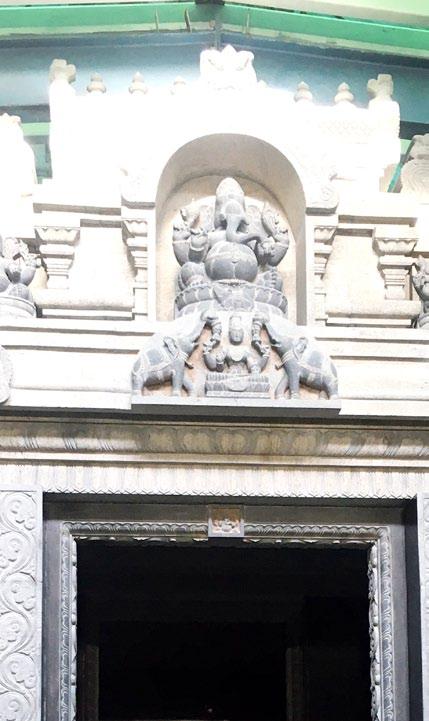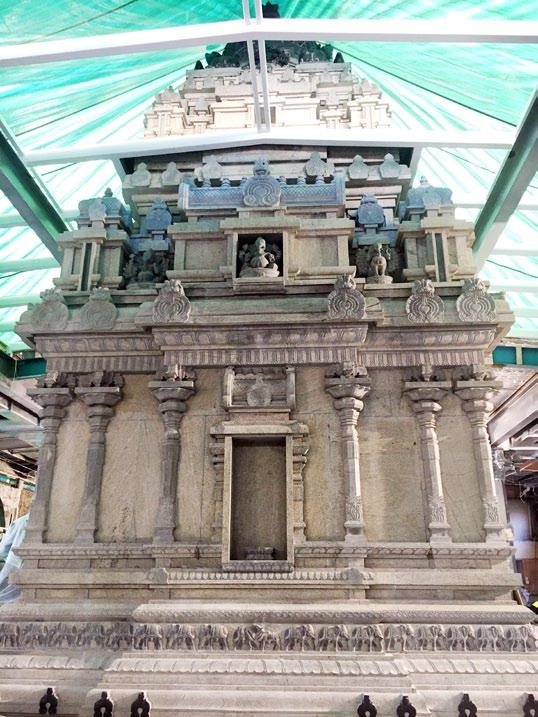
3 minute read
A history of the Sri Vakrathunda
from 2020-07 Sydney
by Indian Link
The temple was first conceived in 1989, when a breakaway group moved away from the Hindu Society of Victoria, frustrated at the slow progress in the development of a Ganesha temple.
Tracing the history, Shan Pillai said, “We procured a church building no longer in use, close to the city. A pro-tem committee was founded with trustees, members and volunteers, and with donated funds, we began the process of building the temple in 1990.”
The deity was given to them by Kanchi Shankaracharya. Shan and his wife went to India to source a deity that they wanted blessed by the Shankaracharya. They could not find one, but paid a visit to the Shankaracharya regardless, and were pleasantly surprised when he offered them a deity.
“Our association with Kanchi is therefore very long and very deep,”Shan said with reverence. “We have gone back for every consecration.”
(It would turn out to be the first of many “miracles” in the journey of the construction of this temple, miracles in which challenges that cropped up were magically sorted out – almost as if Ganesha himself, the Remover of Obstacles, was clearing the barriers for this devout group of Melbournians.)

In Melbourne, in the absence of formal premises, the deity lived in the home of devotees Mr and Mrs Somasundaram for eighteen months and was taken out every month for worship at a local hall where devotees gathered.
“500 devotees turned up in those early days. It was a number we never expected, but it only strengthened our resolve to build a temple to our Ganesha”.
Soon after, the Melbourne Vinayagar Hindu Sangam (MVHS) came into being as a registered non-profit organisation. Stapathi Purushothaman came in 1991 to design the first Ganesha Temple in
Victoria. The kumbabhishegam of the temple was carried out in 1992.
By 2019, the Sangam had acquired four surrounding properties, the last of which was procured at $1.3 million.
For the second consecration in 2007 (Hindu temples have to be consecrated every 12 years or so), Purushottaman extended the temple premises and added a unique raja gopuram (grand entrance), built partly in granite sourced from India and partly in concrete.
The following year, the ten-day Mahotsava festival was launched, now an annual affair. The major highlight of this festival is the chariot procession held on
Much to the disappointment of thousands of devotees, the latest COVID-19 lockdown in Melbourne has caused delays in the consecration ceremony (Maha Kumbabhishegam) of the largest Hindu temple in the Southern Hemisphere made with handmade granite stones.
Dedicated to Hinduism’s most-loved deity Ganesha, the Sri Vakrathunda Vinayagar Temple in The Basin recently underwent a historic transformation in its architecture, with granite used for all eleven of its shrines. Granite is typically used for the construction of Hindu temples and the decorations, as well as the deities within.
“We are proud to say our temple now becomes the largest Hindu temple in Victoria and in the Southern Hemishphere built in the traditional style of our ancestors,” Balaa Kandiah, the president of the Melbourne Vinayagar Hindu Sangam (MVHS) told Indian Link.
Granite is a highly durable stone, making it ideal for temple use as it can last thousands of years. It is also scratch proof, very strong and siliceous. But ancient Hindu temple architecture lists that granite is chosen as it is the only stone where all five elements of natureearth, water, air, fire, and space - can be found.
“It’s a kind of ‘living stone’, so our statues capture the vibrations of the music, the chanting and the prayers conducted within the temple,” Shan Pillai, Secretary of the MVHS said.
More than 1,200 stones were used for this project, with the main shrine of Lord Ganesha alone built from 17 layers of almost 400 granite stones.
Architect Purushothaman (Puru) Jayaraman designed and executed the complex project, inspired by the drawings on the iconic Hindu temples in Tamil Nadu built by Raja Raja Chola.
Puru has had a lifelong fascination for temple architecture, taking on a five-year diploma in Architecture and Sculpture from the one and only College of Traditional Hindu Architecture and Sculpture at Malappuram, Tamil Nadu, India, and a three-year specialised degree in Traditional Architecture and Sculpture from the University of Madras.
He came to Australia with vast experience, having designed Dravidian Chola style temples in India, Sri Lanka, Malaysia, USA Singapore and Australia.
“All the granite used in the temple was sourced from a single quarry, in Namakkal near Salem, Tamil Nadu,” he explained. “This was done to ensure uniformity in colour and texture. The stones varied in size and weighed between 200kg and 6 tonnes each.”
The main temple tower is carved out of a single giant stone, weighing 6 tonnes and 1.19 metres in diameter.
(Called the ‘vimana’, the main temple tower is typically shaped like a pyramid, rising in steps geometrically.)
Nearly 100 artisans worked on the statues, in three different sites in Tamil Nadu.
“They took a year to create - cut and carved in intricate designs. It then took six months to assemble here in Australia.”










